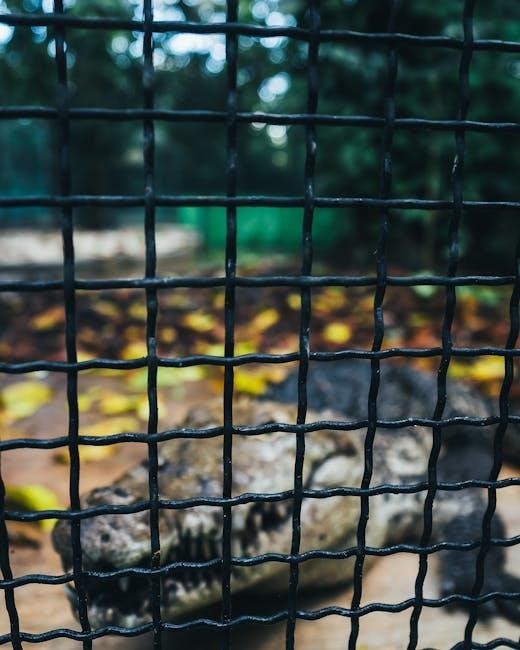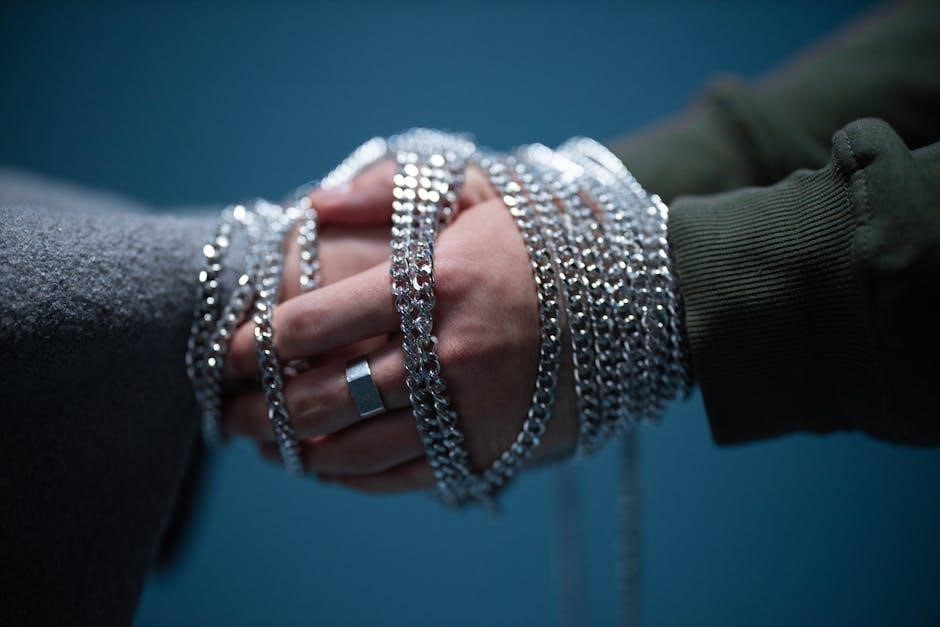
Understanding chain link fence details is crucial for ensuring proper fabrication, installation, and durability. This guide covers specifications, materials, security features, and applications, ensuring a versatile and secure fencing solution.
Overview of Chain Link Fences
Chain link fences are versatile and durable fencing systems made from interwoven steel wires. They are widely used for residential, commercial, and industrial purposes due to their cost-effectiveness and ease of installation. Featuring a mesh pattern, these fences provide visibility and security while being adaptable to various heights and configurations. The galvanized or vinyl-coated wires ensure longevity, making them a practical choice for diverse applications.
Importance of Detailed Specifications
Detailed specifications are essential for ensuring chain link fences meet safety, durability, and aesthetic requirements. They outline material standards, such as wire gauge and mesh size, and installation practices, guaranteeing compliance with ASTM and other industry norms. Proper specifications prevent structural weaknesses, ensuring fences withstand environmental stressors and last longer. They also guide fabricators and installers, minimizing errors and enhancing overall performance. Adhering to detailed specs ensures fences are secure, cost-effective, and tailored to specific needs, whether residential or industrial.
Materials and Components
Chain link fences are constructed from durable materials like galvanized or vinyl-coated wire, steel posts, rails, and accessories such as tension bands and tie wires for secure installation.
Wire Fabric Specifications
Wire fabric for chain link fences is typically made from galvanized or vinyl-coated steel wire, available in various gauges such as 9-gauge (3.4mm) or 11-gauge (2.75mm). The mesh size is commonly 2 inches (50mm), woven in a diamond pattern for strength and durability. Fabric must comply with ASTM standards for quality and performance. Top and bottom selvages are knuckled or welded for secure attachment to posts and rails. Coatings ensure corrosion resistance, while vinyl options offer color variety. Proper fabric specifications ensure a long-lasting, secure, and visually appealing fence system.
Post and Rail Requirements
Posts and rails are critical for the structural integrity of chain link fences. Terminal posts are typically 4 inches in diameter with a wall thickness of 0.110 inches for heights over 6 feet, while line posts are 3 inches in diameter with 0.042 inches thickness. Rails are usually 1 5/8 inches in diameter. Posts must be set in concrete footings, with spacing depending on fence height and local building codes. Galvanized or coated materials ensure durability and resistance to corrosion, providing a sturdy framework for the wire fabric.
Accessories and Hardware
Essential hardware includes tension bands, tie wires, and truss rods to secure and tighten the fabric. Loop caps and dome caps protect posts, while brace bands enhance stability. Truss rods provide additional support for taller fences. Accessories like barbed or razor wire can be added for security, and bottom tension wires prevent sagging. All components are typically made from galvanized steel for durability, ensuring a secure and long-lasting fencing system that meets structural and safety requirements.

Installation and Construction
Installation involves setting posts, attaching fabric, and ensuring proper alignment. Concrete footings secure posts, while truss rods provide additional support for stability and structural integrity during construction.
Site Preparation and Clearing
Site preparation involves clearing the fence line of debris, vegetation, and obstructions to ensure a smooth installation. The area must be accurately marked and leveled. Concrete footings are prepared for terminal posts, while line posts are spaced evenly according to design specifications. Proper clearing ensures the fence is erected straight and securely, adhering to project plans and safety standards for long-term durability and stability.
Post Installation and Alignment
Post installation requires precise alignment and secure anchoring. Terminal posts are set in concrete footings, ensuring stability. Line posts are spaced according to design, typically 6-10 feet apart, and aligned with string guides. Each post is checked for plumb and level to maintain structural integrity. Proper alignment ensures the fence fabric hangs evenly and tension is distributed correctly, preventing sagging and damage. Misalignment can lead to costly repairs, making accurate installation critical for durability.
Fabric Stretching and Tensioning
Fabric stretching ensures the chain link material is taut and evenly distributed. Tension bands are securely attached to terminal posts, and the fabric is stretched using a torque wrench or come-along tool. Proper tensioning prevents sagging and ensures structural integrity. Truss rods or tension wires may be added for additional stability, especially in high-wind areas. The fabric is then tied to line posts with wire ties, maintaining uniform spacing and alignment for a professional finish and long-lasting durability.
Fence Heights and Dimensions
Chain link fences are available in standard heights ranging from 4 feet to 12 feet, with custom options beyond. Dimensions must comply with local regulations and load conditions for stability and safety.
Standard Height Options
Standard chain link fence heights range from 4 feet to 12 feet, with common options including 4′, 6′, 8′, 10′, and 12′. These heights are suitable for various applications, from residential yards to industrial sites. Heights are measured from the base to the top of the fabric, ensuring proper coverage and security. Posts and hardware are selected based on the specified height to maintain structural integrity. Local regulations may dictate maximum allowable heights, especially for residential areas, ensuring compliance and safety standards are met.
Custom Height Requirements
Custom chain link fence heights are tailored to meet specific needs, such as industrial security or unique landscaping demands. Heights beyond standard options require specialized engineering to ensure structural stability. Fabric, posts, and rails must be proportionally adjusted for taller fences, with reinforced materials to withstand wind loads and maintain durability. For heights exceeding 12 feet, additional support systems like truss rods or heavier-gauge wire may be necessary to prevent sagging and ensure long-term performance. Custom solutions must comply with local building codes and safety standards.
Security Features
Chain link fences offer enhanced security with barbed or razor wire toppings and anti-climb measures. High-tensile wire fabric and reinforced posts ensure durability and resistance to tampering, meeting ASTM standards.
Barbed Wire and Razor Wire Options
Barbed wire and razor wire enhance security for chain link fences. Barbed wire features sharp, protruding barbs spaced evenly, while razor wire includes flat, cutting edges. Both options are installed along the top of fences or around gates to deter intruders. Typically, 3 strands of barbed or razor wire are used for maximum security. These wires are made from high-tensile galvanized steel, ensuring durability and resistance to corrosion. Their intimidating appearance and physical deterrent properties make them ideal for high-security applications, complying with ASTM standards for safety and effectiveness.
Anti-Climb and Anti-Cut Measures
Anti-climb and anti-cut measures are essential for enhancing chain link fence security. These include curved top rails, anti-climb spikes, and tight mesh sizes to prevent scaling. For anti-cut protection, high-gauge wires or specialized materials like stainless steel are used. Additionally, features such as wire rope or cable reinforcements can be integrated to resist cutting tools. These measures ensure the fence remains impenetrable, providing robust security for high-risk applications while maintaining durability and compliance with safety standards.

Maintenance and Repair
Regular maintenance and prompt repairs are vital to extend the lifespan of chain link fences. Inspections for rust, sagging, or damage ensure structural integrity and functionality.
Routine Inspection and Care
Regular inspections are essential to identify potential issues early, such as rust, sagging, or wire damage. Cleaning the fence with mild detergent prevents dirt buildup and corrosion. Inspect wire mesh, posts, and connections for wear or damage. Touch up rusted areas with galvanized paint to maintain durability. Ensure hardware like tension bands and tie wires is secure. Routine care extends the fence’s lifespan and maintains its structural integrity and appearance.
Common Repairs and Solutions
Common issues with chain link fences include wire damage, rust, and post instability. Replace damaged wires or sections promptly to maintain security. Apply galvanized paint to rusty areas to prevent further corrosion. Loose posts can be stabilized with additional concrete footings. Tighten loose hardware like tension bands and tie wires. For sagging fabric, adjust tension or install truss rods. Addressing these issues early prevents major repairs and ensures the fence remains durable and secure over time.

Cost and Budgeting
Chain link fence costs vary based on materials, labor, and height. Galvanized or vinyl-coated wire, post sizes, and hardware impact expenses. Budgeting should include long-term savings from minimal maintenance and durability.
Material and Labor Costs
Material costs for chain link fences include galvanized or vinyl-coated wire, posts, and hardware. Labor costs cover installation, including site preparation, post setting, and fabric stretching. Factors like wire gauge, post size, and height influence expenses. High-quality materials, such as thicker wire or vinyl coatings, increase initial costs but ensure durability. Labor costs vary based on location, complexity, and local wages. Detailed specifications help estimate budgets accurately, balancing material quality and installation efficiency for long-term savings.
Long-Term Cost Efficiency
Chain link fences offer long-term cost efficiency due to their durability and low maintenance requirements. High-quality materials, such as galvanized or vinyl-coated wire, resist corrosion and extend lifespan. Minimal upkeep reduces ongoing expenses, while the fence’s versatility allows for easy repairs or upgrades. Compared to other fencing options, chain link fences provide exceptional value over time, making them a cost-effective solution for both residential and commercial applications.

Applications and Uses
Chain link fences are versatile, commonly used for residential, commercial, and industrial purposes, including pool enclosures, sports facilities, and temporary construction barriers, ensuring safety and security.
Residential and Commercial Uses
Chain link fences are widely used in residential settings for backyard security, pool enclosures, and pet containment. Commercial applications include parking lots, warehouses, and construction sites. They provide visibility, durability, and cost-effectiveness, making them ideal for both privacy and security needs. Galvanized or vinyl-coated wire options enhance aesthetics while maintaining functionality. Their versatility ensures they meet diverse fencing requirements across various properties, offering a practical solution for boundary demarcation and access control.
Industrial and Security Applications
Chain link fences are ideal for industrial and high-security environments, offering robust protection for perimeters, prisons, and airports. They often feature barbed or razor wire for enhanced security. Customizable heights, anti-climb measures, and reinforced frameworks ensure durability and resistance to breaches. These fences are widely used in industrial plants, military bases, and sensitive infrastructure due to their strength and visibility. ASTM-compliant materials guarantee reliability, making them a preferred choice for securing high-risk facilities and ensuring operational safety.
Safety Considerations
Chain link fences ensure pool and playground safety, preventing accidental entries and injuries. They also provide structural integrity in high-wind and load conditions, enhancing overall safety standards.
Pool and Playground Safety
Chain link fences are essential for securing pools and playgrounds, ensuring child safety and preventing accidents. Fences should be at least 4 feet tall with tight mesh sizes to avoid climbing. Gates must be self-closing and latched securely. For pools, fencing helps prevent unauthorized access, reducing drowning risks. Playground fencing protects children from wandering off and safeguards against hazards. Proper installation ensures compliance with local safety codes, providing a secure environment for recreation and leisure activities while maintaining visibility for supervision.
High-Wind and Load Conditions
Chain link fences are engineered to withstand high-wind and load conditions, ensuring stability and safety. Proper installation includes reinforced posts, deep concrete footings, and tight wire fabric tension. Truss rods and tension bands provide additional structural support. For extreme conditions, 7-wire strand cables and heavier gauge materials are recommended. These enhancements ensure the fence remains secure, preventing damage from strong winds or heavy loads, while maintaining its durability and reliability in challenging environments.